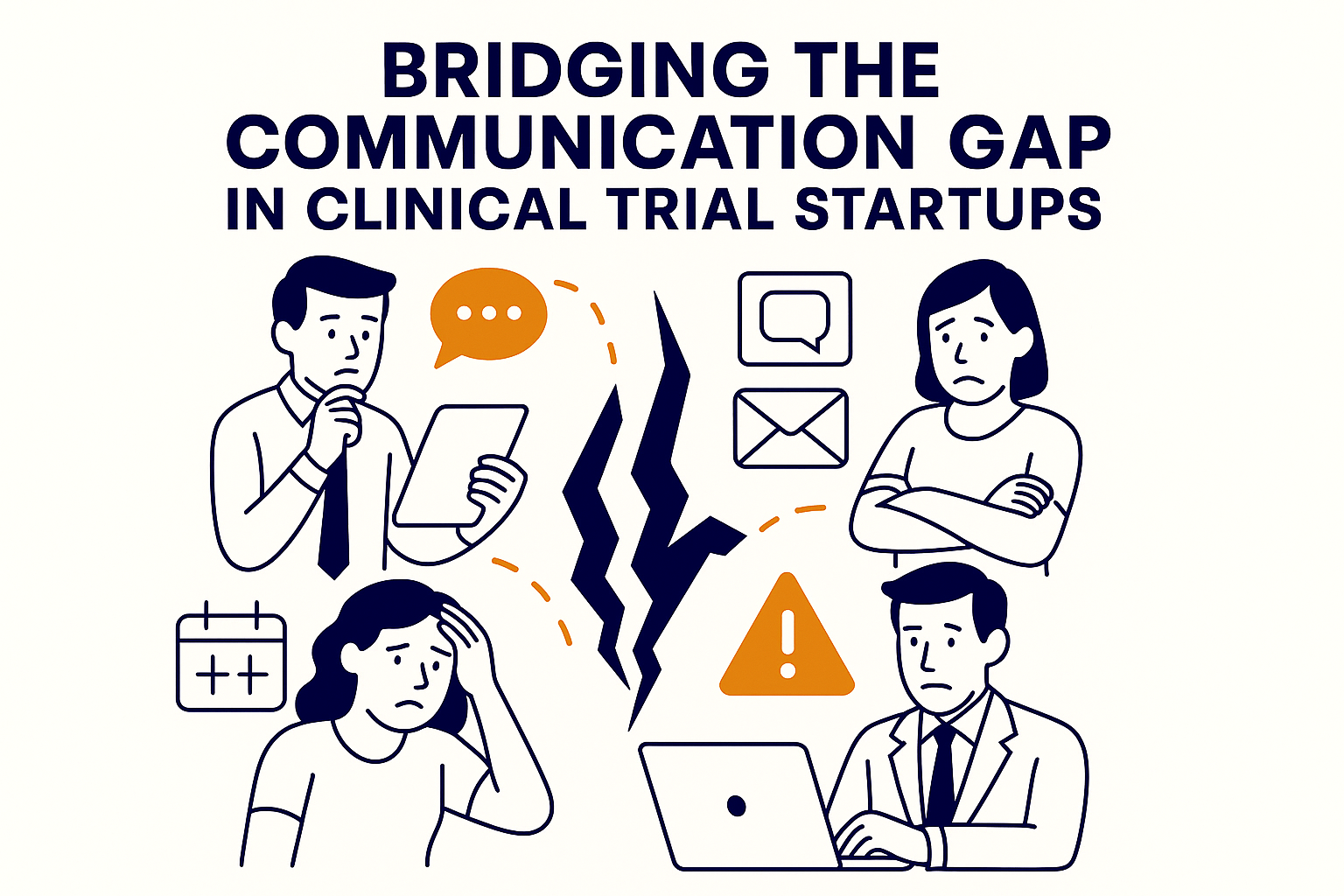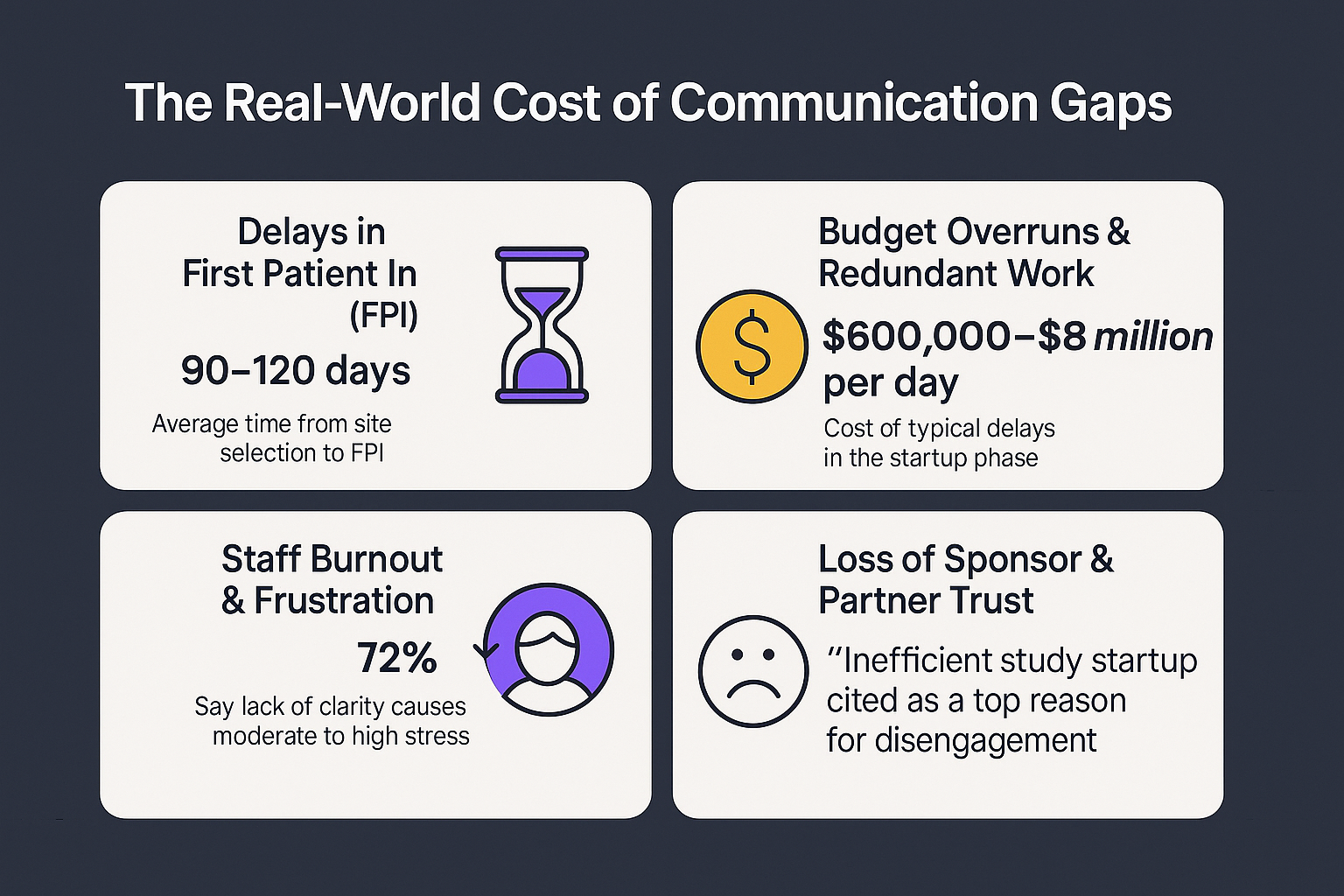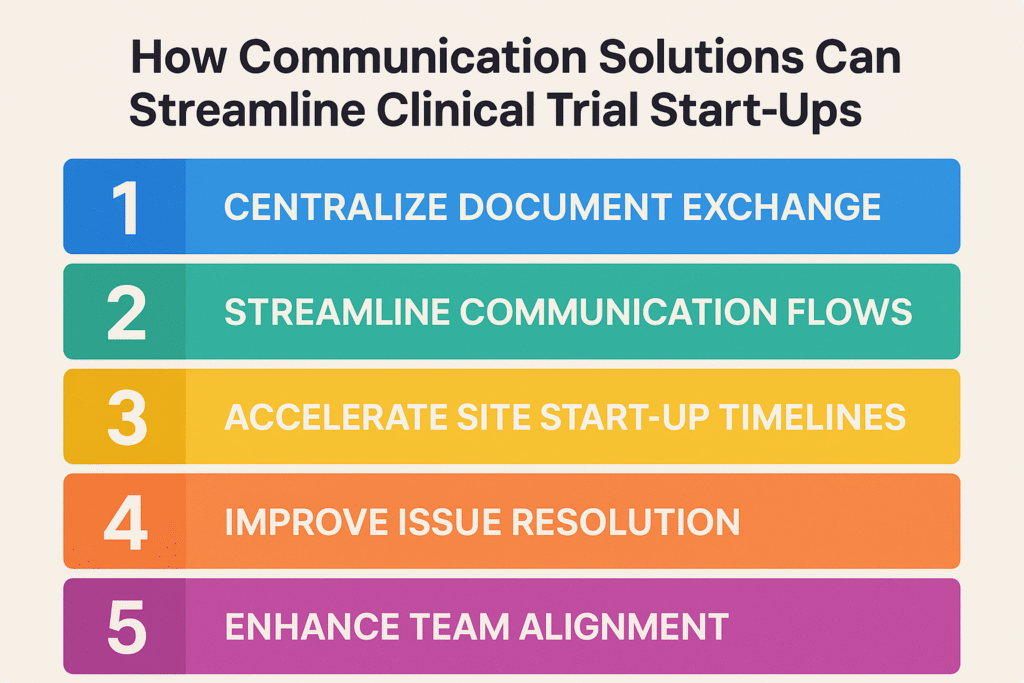
The Hidden Cost of Miscommunication
Imagine this: your team is ready to activate a promising new clinical trial. The protocol is finalized, the sponsor is eager, and your site is set to recruit. But then… silence. An important email gets buried. Someone’s working off an outdated spreadsheet. Updates don’t reach the right people. And just like that, a simple miscommunication delays your timeline by weeks.
You’re not alone. Across independent research sites, academic medical centers, and CROs, one of the most common—and costly—challenges during study startup is fractured communication.
According to the Tufts Center for the Study of Drug Development, protocol development and site initiation delays account for 45% of all startup time loss.
And in a 2023 industry survey, 78% of research professionals cited “lack of centralized communication” as their #1 operational bottleneck.
These gaps don’t just slow things down. They lead to misaligned teams, increased workload, higher costs, and worst of all—delays for patients waiting on critical therapies.
Let’s explore where these communication breakdowns typically happen, why traditional tools fall short, and how technology like TrialConnx is helping research teams bridge the gap and move faster with confidence.
The Communication Breakdown: Where It Happens
If you’ve ever felt like your clinical trial startup is being run through a patchwork of inboxes, spreadsheets, and scattered systems—you’re not imagining it.
Communication gaps aren’t rare—they’re routine. And they almost always show up in the same places.

1. Feasibility & Site Selection
The Problem:
Feasibility surveys come in all shapes and formats—some late, some incomplete. Teams lose time cleaning up responses, chasing missing fields, and clarifying basic data points.
62% of teams report feasibility delays due to inconsistent responses and fragmented communication. — SCRS, 2023
The Better Way:
Use standardized forms with a centralized portal to reduce back-and-forth and speed up site selection.
2. Budget & Contracting
The Problem:
Budget files pass between legal and finance in endless email chains. Each revision spawns a new version, and no one knows which one is “final.”
4–6 weeks is the average cycle for contract and budget negotiations—35% of that is lost to communication inefficiencies. — WCG Metrics, 2022
The Better Way:
Track budgets in a single workspace with built-in version control and task assignments.
3. Regulatory & IRB Submissions
The Problem:
Final protocols and approval docs get lost in inboxes. Submission statuses are unclear. Teams duplicate efforts—or worse, wait for updates that were never sent.
1 in 3 clinical trial delays stem from document mismanagement. — ACRO Site Survey, 2023
The Better Way:
Centralize document tracking with live status updates and access controls to avoid confusion.
4. Study Start-up Meetings
The Problem:
Meetings are held, but tasks go untracked. Everyone assumes someone else followed up—and no one actually does.
45% of teams report missing key milestones due to poor action tracking after meetings. — Tufts CSDD, 2023
The Better Way:
Use integrated task trackers and automated reminders to ensure follow-through and momentum.
These may seem like small gaps—but together, they cause major delays. Next, let’s look at what those delays actually cost in the real world.
The Real-World Cost of Communication Gaps
Poor communication during startup doesn’t just slow things down—it creates ripple effects that impact nearly every part of the trial.

Here’s what’s at stake when things fall through the cracks:
⏳ Delays in First Patient In (FPI)
Impact: Every missed update, unclear task, or version mix-up pushes back site activation. And every day of delay means a missed opportunity to recruit and a longer path to results.
Industry Insight:
Average time from site selection to FPI is 90–120 days, but sites with streamlined communication can activate in as little as 45 days. — Tufts Center for the Study of Drug Development
💸 Budget Overruns & Redundant Work
Impact: When documents go missing or decisions are repeated due to lack of clarity, teams spend more hours chasing answers and duplicating efforts. That adds up.
Estimated Impact:
A typical delay in the startup phase can cost sponsors and CROs $600,000–$8 million per day, depending on the trial size and phase. — Drug Development & Delivery Report
🔄 Staff Burnout & Frustration
Impact: Teams are tired of redoing work. Constant follow-ups, confusion around ownership, and waiting on approvals all contribute to burnout—and high turnover in study ops roles.
Reported by Teams:
72% of research staff say lack of clarity around timelines and ownership causes “moderate to high” levels of workplace stress. — Applied Clinical Trials, 2023
😟 Loss of Sponsor & Partner Trust
Impact: Delays and disorganization reflect poorly on your operation. A lack of transparency and follow-through can lead sponsors to bypass sites or teams in future studies.
What This Means:
Sponsors cite “inefficient study startup” as a top reason for disengaging from repeat site partnerships. — WIRB-Copernicus Group (WCG) Benchmark Study
When you add it all up, miscommunication isn’t just a hiccup—it’s a blocker to trial success. But these costs are preventable.
How Communication Can Streamline Clinical Trial Startups
You’ve seen where communication breaks down—and what it costs. But what does it look like when communication actually works?

Here’s a step-by-step view of how streamlined communication transforms startup operations:
1. Centralize Document Exchange
No more searching across email threads, folders, or portals. All study-related documents—from feasibility forms to protocols—live in one centralized, secure space.
Result: Faster access, fewer versioning issues, and reduced time spent tracking down files.
2. Streamline Communication Flows
Teams collaborate in real time, and messages don’t get lost in inboxes. Everyone’s connected through one platform.
Result: Fewer meetings, faster decisions, and smoother sponsor-site alignment.
3. Accelerate Site Start-up Timelines
Automated workflows and task tracking ensure key startup milestones (like budget approval and IRB submission) don’t fall through the cracks.
Result: Site activation can move from 90+ days to under 45.
4. Improve Issue Resolution
Bottlenecks and blockers are flagged instantly. Teams know who owns what, and next steps are clear.
Result: Fewer delays, quicker fixes, and higher team confidence.
5. Enhance Team Alignment
Shared dashboards and live status views give everyone—from study coordinators to sponsors—a unified understanding of progress.
Result: Transparency builds trust and momentum across the trial.
Final Thoughts: Start with Communication, End with Impact
Clinical trial startup is one of the most complex and fast-moving phases in research—and yet, it’s often held back by one of the most fundamental issues: miscommunication.
But here’s the good news: this is a problem we can solve. By recognizing where gaps occur and intentionally designing smarter, more transparent workflows, we can activate trials faster, collaborate more effectively, and ultimately deliver outcomes that matter—faster and more efficiently.
Whether you’re coordinating IRB approvals, navigating budget negotiations, or leading cross-functional startup meetings, clear communication isn’t just helpful—it’s mission-critical.


